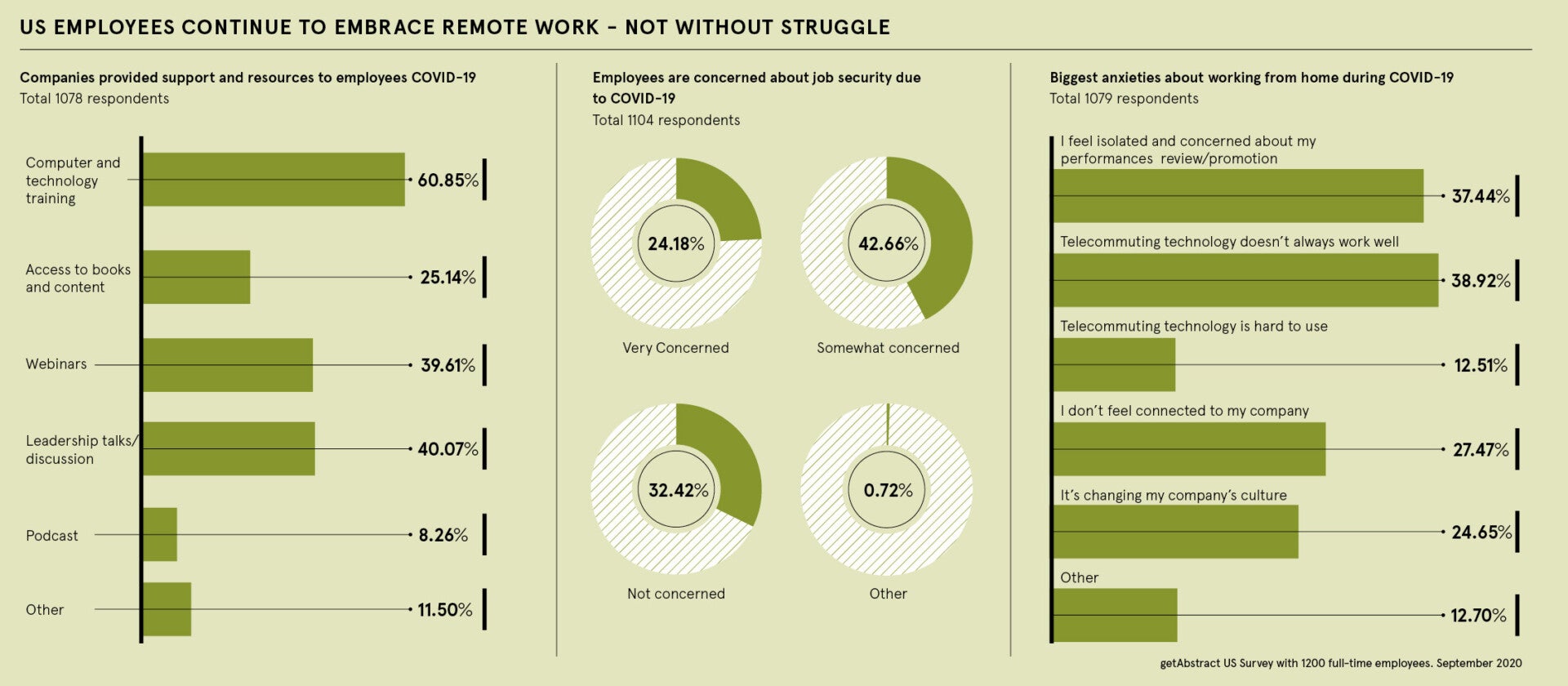
In the initial stages of the coronavirus pandemic, organisations had very little time to think about the advantages and disadvantages of various workforce models. There was only one option on the table, so enabling an immediate transition to remote working was prioritised to keep companies operational during an unprecedented crisis. As days turned into weeks and weeks into months, however, even the most traditional organisations came to accept that their employees kept productive with relative ease.
When the pandemic is finally over, therefore, it’s unlikely the world of business will return to its previous status quo. Remote working, at least in some form, is undoubtedly here to stay, as companies have discovered a whole raft of meetings and tasks that are so much more efficiently conducted online, rather than commuting into an office. Equally, however, the pandemic has exposed many of the downsides of remote working.
While a study by getAbstract in September found that US workers are mostly supportive of working from home, 67 per cent reported feeling concerned about their job security and 89 per cent felt isolated, disconnected from their companies or distracted and less productive at times. It’s clear remote working doesn’t work for everybody, certainly not all the time. This has caused organisations, including getAbstract, to reimagine what their workplace will look like in the future.
“For many companies, there will be a new way of working together and that way is hybrid,” says Thomas Bergen, co-founder and chief executive of getAbstract, the world’s largest online library of summarised content. “We already no longer view the office as our workplace per se, because most of us can work more easily and efficiently from home. But what is the advantage of the office? It’s the informal contact and exchange of ideas.

“This is exactly what we are trying to achieve right now with rebuilding our office. It will be a space where we meet and gather to exchange ideas, launch projects and have informal interactions, not regularly but on a more random basis. We are installing, for example, a nice kitchen, and on a weekly basis we will have a cook prepare a great lunch for everyone.
“People won’t come to the office because they have to, but because they want to, and for the informal meetings for which we will build space to facilitate. They’ll also invite customers to give them an understanding of who we are and how we work.”
For getAbstract, and indeed numerous other organisations that are currently considering a new workplace model, this blended approach will be more befitting of people’s expectations. It will not only maximise productivity, but also attract better talent, as the pandemic has ushered in new possibilities to create an environment where people’s private lives and professional lives align in much better harmony.
At least for some initiatives, the pandemic has also been the final nail in the coffin of traditional classroom-based employee training. Onboarding processes, for instance, where companies train people for weeks or even months, had to change as people could no longer meet, exposing the more traditional companies to the value of online learning.
This means it’s not just the future of work that’s hybrid, but the future of learning too, and on both a corporate and an individual level. Companies are investing more time and energy into online learning initiatives than ever before, as they seek the knowledge and agility to pivot their operations and business models. Equally, many individuals, particularly in the sectors most blighted by COVID-19, have realised they need to be agile and, to make themselves most employable, they cannot stop learning.
It’s not just the future of work that’s hybrid, but the future of learning too
“Those not adapting to this new world, or the new ways of doing business, are just no longer in the market, they are dropping out,” says Bergen. “Most people don’t want to go back to the pre-COVID working environment, but they must ensure their skills are still relevant and in demand. And it’s practically impossible now for a company not to develop a learning and training strategy for the whole workforce. I believe in the long run, COVID-19 will lead to more responsibility for every employee.”
The expert editorial team at getAbstract finds and rates the most relevant business books, articles, video talks, and podcasts and summarises them into ten-minute abstracts. By constantly updating its online library of text and audio summaries, currently standing at more than 20,000, getAbstract provides quick, easy access to relevant information for employees at every level, giving them the knowledge to make better business and career decisions.
The flexibility of getAbstract’s learning platform also means global companies can take a more nuanced approach to working and learning. For all the value of remote working and learning, there will always be industries, departments and regions where the benefits of meeting in person outweigh what can be achieved from home. The ability for global corporations to choose the right model for the right scenario will be paramount.
“The future of learning is brighter than ever,” says Bergen. “Most companies and employees figured out that such a crisis means they have to adapt and to adapt successfully you have to learn. You have to change your behaviour and behaviour change is a learning process. Learning is one of the key elements of mastering the future, individually and for corporates, and those not willing to learn will ultimately fail.
“Companies with a learning culture are really strong. In a world where the lines between real and fake information is increasingly blurred, the ability to quickly find and digest relevant knowledge, which has been summarised, rated and put in the right context, is crucial to continually learning and making smarter and faster decisions. We’ve been doing that for 21 years, and we are hiring and growing faster than ever.”
For more information please visit getabstract.com
Promoted by getAbstract

In the initial stages of the coronavirus pandemic, organisations had very little time to think about the advantages and disadvantages of various workforce models. There was only one option on the table, so enabling an immediate transition to remote working was prioritised to keep companies operational during an unprecedented crisis. As days turned into weeks and weeks into months, however, even the most traditional organisations came to accept that their employees kept productive with relative ease.
When the pandemic is finally over, therefore, it’s unlikely the world of business will return to its previous status quo. Remote working, at least in some form, is undoubtedly here to stay, as companies have discovered a whole raft of meetings and tasks that are so much more efficiently conducted online, rather than commuting into an office. Equally, however, the pandemic has exposed many of the downsides of remote working.
While a study by getAbstract in September found that US workers are mostly supportive of working from home, 67 per cent reported feeling concerned about their job security and 89 per cent felt isolated, disconnected from their companies or distracted and less productive at times. It’s clear remote working doesn’t work for everybody, certainly not all the time. This has caused organisations, including getAbstract, to reimagine what their workplace will look like in the future.

